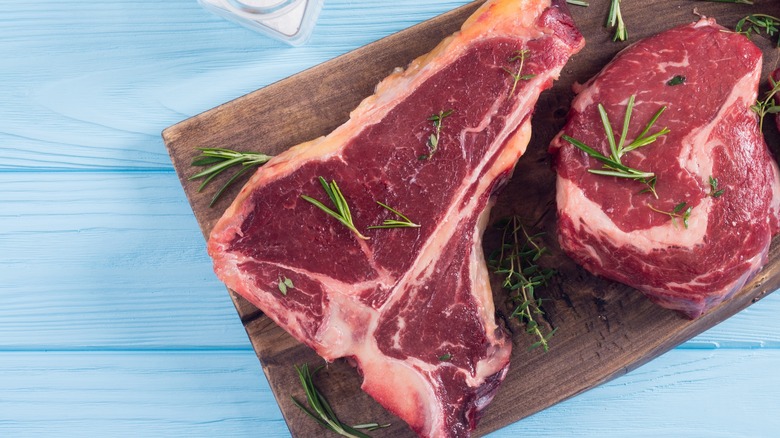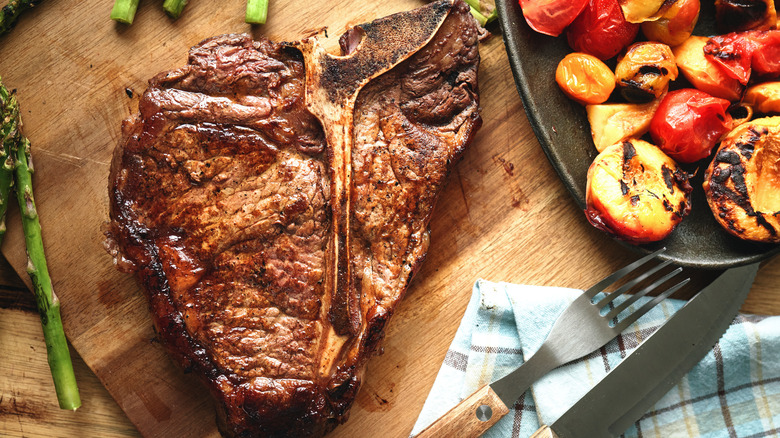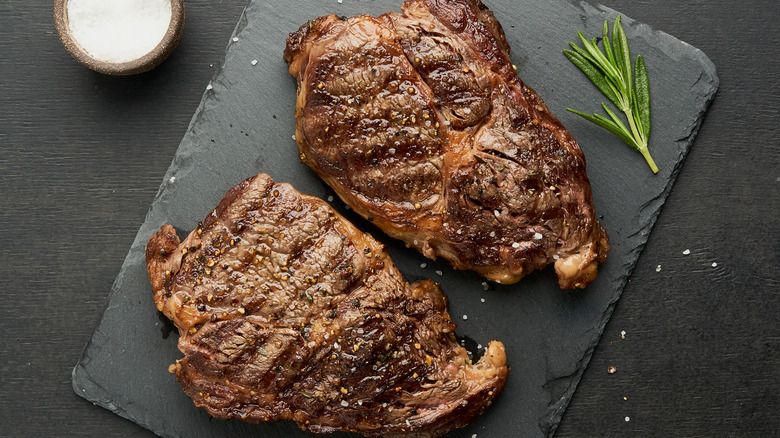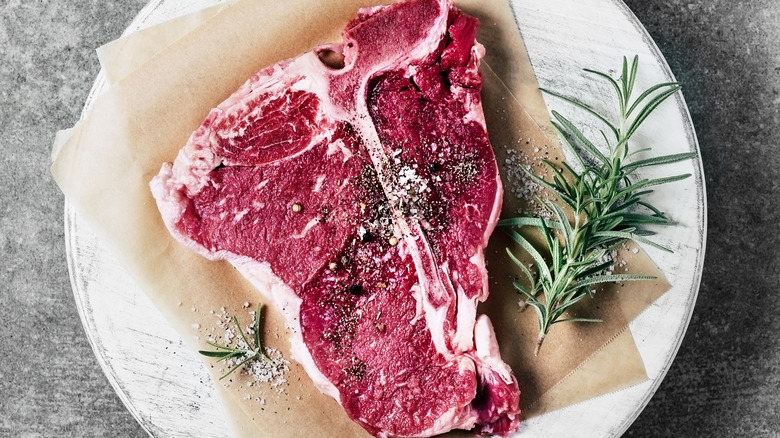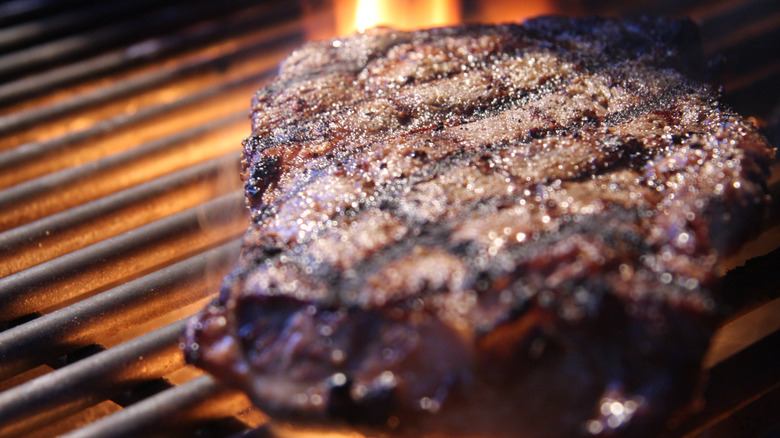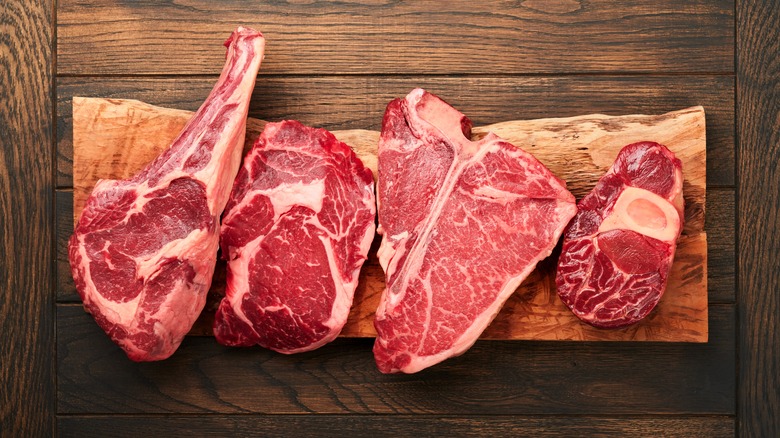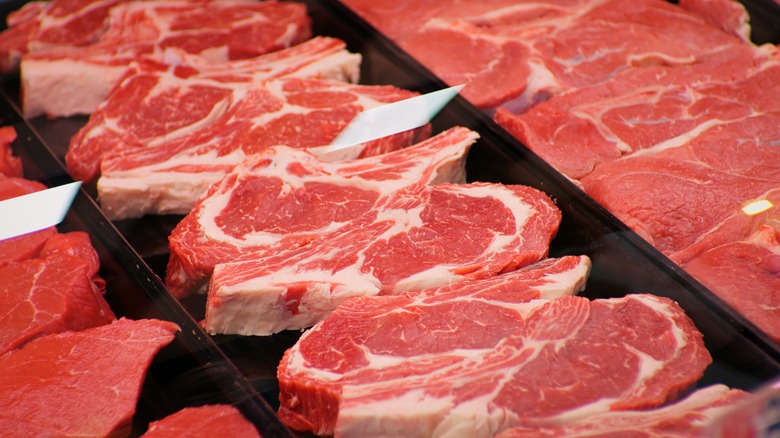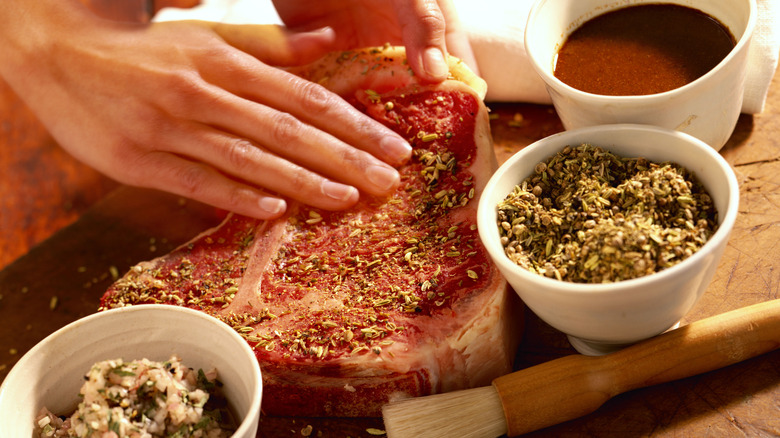T-Bone Vs Ribeye Steak: A Chef Explains Everything You Need To Know
If you're not quite a steak aficionado, it can be challenging to pick the perfect cut of meat for your next meal. While there are dozens of different steak options out there, it can be especially challenging when it comes to choosing between highly desirable options like T-bone and ribeye steaks. While they are each both delicious in their own way, there are a few key differences between the two. Instead of picking at random, learn more about each of these beloved cuts from the experts to find the best option for your next meal.
Troy Guard, owner and executive chef at TAG Restaurant Group, and Kylian Goussot, executive chef at Lafayette Steakhouse, weigh in on everything you need to know about these two sought-after cuts of steak. Learn more about the pros and cons of each from these steak experts to expand your knowledge and help make a more informed decision.
What is a T-bone?
T-bone steak is a sought-after cut that comes from the short loin of a cow, just behind the ribs. The short loin is a part of the larger loin primal cut and is often considered to have some of the cow's most desirable steaks. Along with the T-bone steak, the short loin also includes strip, porterhouse, and tenderloin steaks. Like all steaks, these cuts are a delicious and nutritious source of protein, vitamins, and minerals.
In a T-bone steak, the iconic T-shaped bone running down the middle separates two different cuts: strip steak, and filet mignon (also called tenderloin). The strip steak has a deep, beefy flavor while the filet mignon is known for its melt-in-your-mouth, marbled, buttery texture. But the reason many people love T-bone steak is because you get the best of both worlds: two flavorful steaks in one delicious dish.
"This steak offers two distinct textures and flavors due to the combination of strip steak and tenderloin," said Goussot. "The strip side is flavorful and slightly firmer, while the tenderloin side is more tender."
What is ribeye?
Unlike the T-bone steak, ribeye steak comes from the beef rib primal cut of a cow. Like the short loin, the beef rib primal cut is home to many beloved steak cuts like rib roast and short ribs. More specifically, the ribeye is usually sourced from the sixth to the 12th ribs. This prized cut gets its name because it is in the center, or "eye" of the cow. It is also known by a few other names, including Spencer steak or Scotch filet depending on your region.
This cut is also known for its beautiful marbling and high fat content, which delivers juicy and tender steaks. Ribeye has a length of fat running through the steak, contributing to its rich, umami flavor. While ribeye steaks can be purchased bone-in like T-bones, they are more commonly found boneless to make both cooking and eating the steak a bit easier.
T-bone offers more bang for your buck
Though both ribeye and T-bone steaks are considered prime cuts, boneless ribeye demands a bit of a more premium price. Not substantially different at most butchers, ribeye is usually the more expensive of the two – which means that a T-bone steak is the more economical option if you're trying to watch your grocery budget. You'll also get the diverse flavor of the two cuts, all for the price of one.
The price advantage of a T-bone steak doesn't stop there. While you are paying for the center bone that runs through the steak (which is inedible) you can save the marrow-filled bone to make homemade bone broth or stock. This not only helps to minimize food waste, but will add immense flavor to homemade broth for your next soup or stew. Just avoid a few common pitfalls for the most delicious broth possible.
Ribeye offers more versatile cooking methods
Because they are naturally tender, ribeye steaks can be cooked in many different ways. The meat has a natural, rich flavor that doesn't require any fancy marinades or seasonings. Instead, simply cook it in a pan with basics like salt, pepper, and butter, and it still delivers a steakhouse-quality meal. When cooking ribeye, opt to use the stove, oven, or grill (or a combination) to create a nice seared exterior and an interior that caters to any preferred level of doneness. Ribeyes can also be smoked, sous vided, fried, or even broiled to bring out their natural flavor.
T-bone steaks, on the other hand, should be cooked on the stovetop, on the grill, or in the oven. Because this steak has two different cuts and a center bone, it requires a bit more finesse and attention to help ensure all of the meat cooks evenly.
T-bone steaks are typically larger
Because they contain two different cuts and a large middle bone, T-bone steaks are typically larger than other steaks — and especially ribeyes. Though T-bones come in a variety of sizes like all steaks depending on the cut and the cow, it is usually a thick, large steak. Often cut between 1 ½ and 2 inches, the average T-bone can be anywhere from 12 ounces to 1 ½ pounds. Though some of this weight can be attributed to the bone, a high-quality T-bone steak will still be up to 85% meat.
This larger size not only makes them well-suited for a family dinner or to feed a crowd, but the diversity in the cut will also help appease different palates. Consider serving a T-bone steak for your next gathering for a striking meal that is sure to impress even the toughest critics — or go out to eat with your friends and family and enjoy the same large cut from a popular chain.
Ribeye is more marbled, higher in fat, and more tender
Because ribeye steak comes from the cow's upper rib — an area without a lot of muscle – it has a higher fat content than other areas of the cow like the loin or the round. As a result, these steaks typically have beautiful marbling that makes them extra tender. It also delivers a lot of flavor and helps keep the steak juicy. If you prefer a less fatty steak, however, T-bone would be the better option because it is a leaner cut.
"In my opinion, [ribeye] is the best cut of steak," said Guard. "It's versatile and absolutely delicious, with exceptional flavor and tenderness when cooked properly. When I have the option, I always choose a good ribeye over any other cut of steak."
Because of the marbling, ribeye is also an easier cut for home chefs according to Goussot. "Ribeye is often easier to cook evenly and has a more forgiving nature," he explained.
T-bone can be more difficult to cook
Because T-bone steaks are made up of two different cuts that cook at different speeds, they can be more difficult to cook. The bone also insulates the meat, which means the steak closest to the bone cooks more slowly. Though you can buy bone-in ribeye steaks, these are a bit more straightforward to cook because the entire steak is made up of one cut (instead of two different cuts like the T-bone).
"T-bone steak can be challenging to cook evenly due to the differing thickness of the strip and tenderloin sections," explained Goussot. "The bone can also make it harder to cook and eat."
Guard agreed: "Since [T-bone steak] is made up of both a tenderloin and a New York strip, it can be a little more difficult to cook." Instead, he recommended individual New York strip steaks as a simpler meal for less experienced home cooks.
